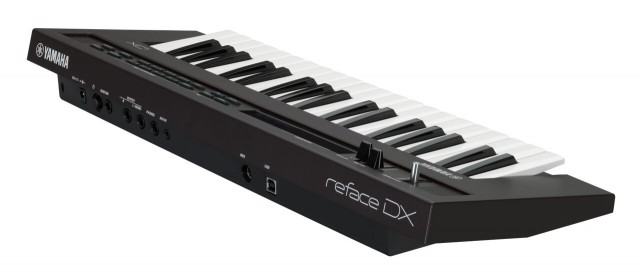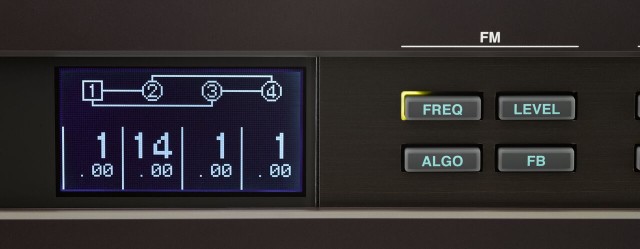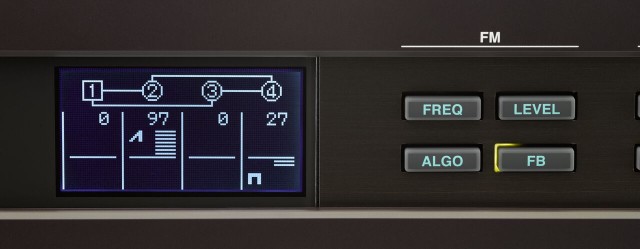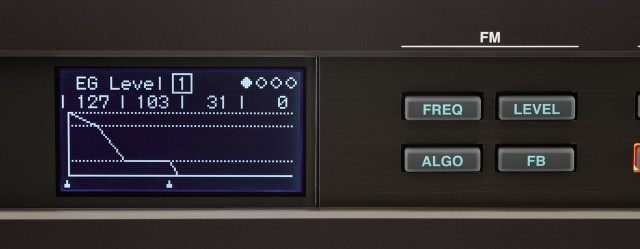
2015 Summer NAMM Show: Yamaha has officially introduced its new Reface Mobile Mini Keyboards line, inspired by four of the company’s classic keyboard lines.
The Reface keyboard line was inspired by the form factor of the Yamaha CS-01, a mini synth that featured a built-in speaker. The new keyboards use a similar form factor, but have sound engines designed to recall four different Yamaha keyboard lines.
The Reface DX synth engine recalls Yamaha’s classic 80’s DX FM synths:

Key features of all the keyboards in the Reface line include:
- built-in speakers
- 37 keys with HQ-Mini action, derived from Yamaha’s flagship Motif XF
- battery-powered portability
- USB & MIDI connectivity
- Yamaha Reface Capture – an iOS patch librarian app
- SoundMondo – a web MIDI patch librarian and social patch sharing site
Yamaha Reface DX Features:
- reface DX draws its inspiration from the iconic DX7, which debuted in 1983, which pioneered FM synthesis and made polyphonic synths affordable.
- A new Multi-Touch Control interface makes it easy to customize your sound with the powerful FM (frequency modulation) synthesis engine.
- 8-note polyphony
- 32 Voice Memories
- Backlit display
- “One to one” control scheme, meaning the panel controls match the tone generator for direct sound creation.
A key features of the Reface DX is its interface, which features a touch control surface, making FM synthesis much ‘friendlier’ than previous hardware FM synths:
Here’s an overview of the new Yamaha Reface DX, via sonicstate:
The Yamaha Reface DX is expected to ship in September 2015, with a street price around US $500. See the YamahaSynth site for more info.










In the age of cheap flash memory, the 32 patch limitation is perplexing. They could have at least done EIGHT banks of eight patches rather than just four.
The price should be something between U$ 150 to U$ 199….way overpriced product.
Amen. At only 32 patches and 8 voices it should be only $150.
ummm…have you seen the interface and OLED display? That alone costs $150.
I agree about the price. Not in a tight-wad way. Yamaha just made so many damn full-featured DX’s that cheap FM boxes saturate the used market. Yamaha will be in direct competition with it’s own history.
uses friendly? u mean dumbed down?
Anyone that’s familiar with the 80’s DX synths will see that this is WAY more immediate to program, which will make it much more usable. No menu-diving!
Keyboard techs will tell you that every DX synth they ever work on comes in with the the factory presets unchanged, because the old synths were a pain to program.
It’s still a mini-synth, though. I’d like to know their plans for full-size versions of these keyboards. A brand new, full-size Reface DX would be pretty killer if they could offer it for around $100 more or os.
He still had to dive a bit just to get to the basic sine wave, but I agree this is way more intuitive. It’s hard because there can be so much available to modulate with FM, but this is a step in the right direction and I hope they keep going, making FM synths more intuitive and fun to program.
can’t see this selling well due to the amount of used DX and TX synths out there still going and they have a way cheaper price
why the stupid limitation of 4 operators and 32 patches?? it’s 2015..
32 years after the DX7, we’ve lost 2 operators..
The DX-7 was sine only, and needed the 6 operators. 4 operator FM is easier to program, and all four operators have feedback on this one, so it could possibly get even more interesting sounds with less work. Having said that, I wish this had the ability to load old patches from 4 and 6 operator FM. But they went for immediacy and easy of programming, and I think that’s smart. It’s a hands-on FM.
As for the limitation of 32 presets, I’m with you there. That’s ridiculous.
That said, Yamahas DX flagship was FS1r and this device had 16 op and 88 Algo, which prove that Yamaha has the technology to make it more complex, they just have to push it a bit harder 🙂
Note that it does not say reface DX7, it says reface DX. There were a few DX models that used only 4 operators, such as the DX27. Really this is more like a reissue of a DX100 than a DX7.
They should call it TX-81Z-inspired 😀
To add to what R M A said….all four with morphing saw/sqare feedback….so I would guess that there will be a fairly wide sonic palette…..quote from the manual below. Had a display model at the music shop here in Canada and I was working my way around it quite quickly. The keys are small but have a good feel to them. The FX section is very basic. The DX is definitely the one I’ll get (when they’re in stock). I had forgotten how big, punchy and clean FM can be….a nice compliment to my analogue gear.
******************
If you move the slider up from the center position, the feedback type becomes saw- tooth ( ) and the feedback level will increase. As a result, the waveform morphs from a sine to a sawtooth shape, and at the maximum level, it is transformed fully into a sawtooth wave. If you move the slider down from the center position, the feedback type becomes square ( ) and the feedback level will increase. As a result, the waveform morphs from a sine to a square shape, and at the maximum level, it is transformed fully into a square wave. At the center position, the feedback level is “0.” Here, none of the signal is fed back and a sine wave is produced.
And we gained a FRIENDLY INTERACE & lovely OLED display.
Worth the $500 just for that.
4 op fm with mini-keys = DX100 redux? Not that 4 op fm is a bad thing: the DX27 / TX81Z were (are) great synths – and while you lost 2 ops, you gained additional wave forms.
But I kinda hoped (expected) for more from Yamaha. These have a very ‘Me Too’ feel to them.
It looks like what they were calling a “touch screen” is actually 8 capacitive touch sensors and 8 red leds representing 4 inc/dec buttons, and you have to do that swipe, swipe, swipe, swipe thing to scroll.
I’ve used that sort of interface on mp3 players, it’s a really frustrating way to scroll.
IF they’d put all four units in one tabletop/rackmount unit with a price of $400
IF DX at least sounded like the mighty TX81Z
IF CS sounded just a little bit like any of the real CSs of the past
THEN It would have been something
As it is, it’s just an expensive toy
There are already plenty of all-in-one keyboards that are jack-of-all-trades and masters of none.
This is taking just the opposite approach and I’d expect that people will find these a hell of a lot easier to use and more fun. Who
They all have the knob–per-function ethos, which just way way way easier to get into than menu-diving. I’ve got a microKorg and MiniNova and, accepting the keyboard size, the UI is the main thing that holds them back from being fun to use.
What a lame product, and the marketing is absolutely laptop hipster hideous!
Why is it lame? This might end up being one of the best-sounding and easiest-to-use FMs Yamaha has made. The programming method is a great concept. They could easily apply this to a full-sized synth and rack unit.
Why do you keep saying “The programming method is a great concept.” You really seem to be trying to push that idea.
The only knobs are volume and octave transposition, plus pitch lever. There’s no data slider even.
Like the older ones, you click on buttons to go to various menus to edit things and click on buttons to select operators. Instead of a data slider though there are capacitive touch sensors, which are much more fiddly and error prone to work with than real switches, real touch panels, sliders or knobs.
The DX instruments were tricky since there was only a single data slider. This reduces that to zero data sliders. That is clearly much much worse. The only parameters with sliders are volume and octave transpose.
Disagree! I have owned all the classic DX’s and the reface is easily the most USER FRIENDLY of them all. It really makes FM programming understandable and intuitive. (for the first time ever really)
ups sorry.. double post
I’m an old guy from the generation of DX7 lovers !!!! I LOVE the idea of a modern DX synth but don’t like the limited memory…. and its over priced for the kind of small hardware it is…. love to see a rack mount version.
the new Motif will have all these modules embedded as the Korg Kronos
This is very interesting! my dx5 weighs a tonne is so big I hardly have room forint , in fact I’m seriously considering selling it, I love it but it’s completely impracticle, I hardly use full sized keys as they feel to plasticky and feel crap despite the full keybed, in fact thinking about it I just use my octotrack to control it so I just use it as a sound module, it uses so much power that if this dx synth gets close to the sound, without all the background noise, has good and easy reliable midi, can easily connect to the computer , I’m in, it’s great to get all romantic about huge old synths but in the end…………
As Newton said physics is not only for physicists, but a natural phenomena for everyone. Here they are taking money for the sound quality. That is the only thing that matters. Welcome to the simple hitech future. Adapt or die.
Should be called slap in the face lol.
All synths should have limited memory. It’s lame to rely on presets – and how many sounds do you need? I would say its better to have eight (ish) buttons giving access to eight (ish) presets (like the op 1, Roland system one, mood sub phatty) than a gazillion presets you need to scroll though. Big up Yamaha. This stuff is AMAZING
I don’t think people want the expanded memory for “presets”, they want it to store their own sounds. For me personally, i dont ever want to load sounds from an external source so the more I can store on the synth, the better. I would still probably choose this over a DX7, but only because of the ability to manipulate sounds live and because the sound quality is probably streaks ahead. I would never take it over my SY77 though. i dont mind only 4 operators – anyone whose messed with a TX81Z will tell you it is better than the DX7 in many respects because of the waveform variations, but 32 patches? Jeez!
Guess I won’t be selling my FS1r anytime soon.
Dear Yamaha – I like the concept here, but I’m one of those old farts that can’t stand mini keys or a limited 3-octave range in a polyphonic synth. I’ll spend my money elsewhere.
Wish i had bought an FS1R when Sam Ash had dropped them to $400!
I play this thing on my lunch at work. It’s actually a really powerful synth. The keys are better than any of my controllers. They use the motif keys I read. If you want an fs1r keyboard get the montage..